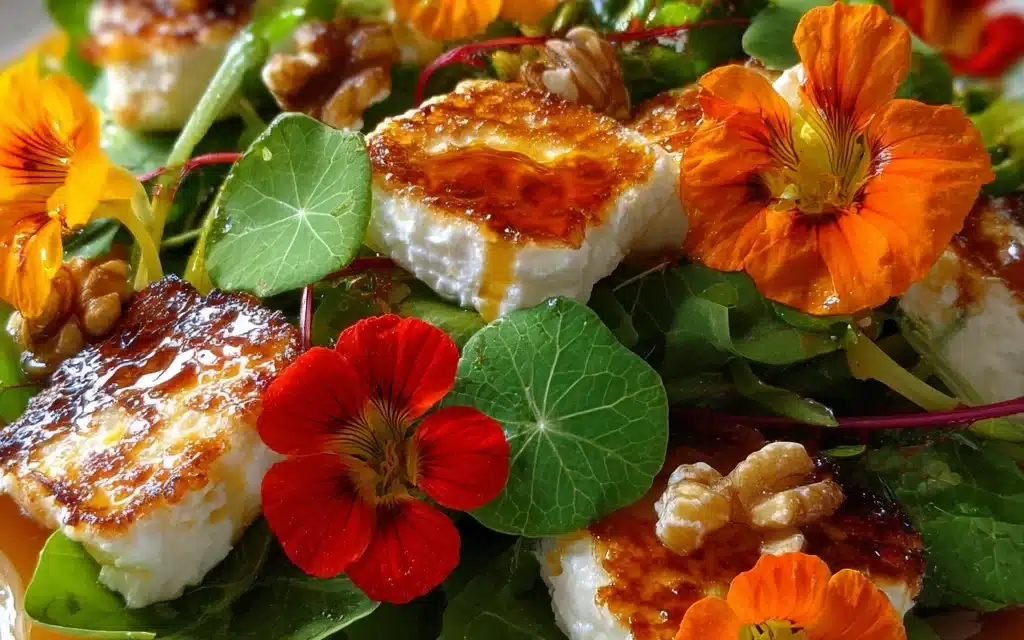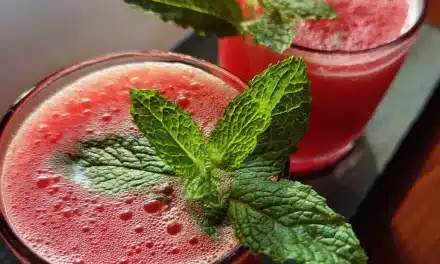Table of Contents
Introduction
Did you know that nasturtiums were once called “nose-twisters” due to their peppery bite that can make your nose scrunch up in delight? This vibrant, edible flower has been gracing gardens and plates since the 1600s, yet many home cooks overlook this culinary gem. A Nasturtium and Goat Cheese Salad brings together the unexpected zesty punch of these edible blooms with the creamy tang of goat cheese, creating a sensory experience that’s as visually stunning as it is delicious. This isn’t just another salad—it’s a celebration of garden-to-table dining that transforms ordinary ingredients into an extraordinary culinary masterpiece.
Ingredients List
Gather these fresh, vibrant components to create your Nasturtium and Goat Cheese Salad. Each ingredient contributes a unique flavor profile to this garden-inspired dish:
- 2 cups fresh nasturtium flowers (both petals and whole flowers), rinsed gently and dried
- 1 cup nasturtium leaves, young and tender for best flavor
- 4 ounces soft goat cheese (chèvre), crumbled or sliced into medallions
- 6 cups mixed salad greens (arugula, baby spinach, and butter lettuce work beautifully)
- 1 cup cherry tomatoes, halved
- 1/2 English cucumber, thinly sliced
- 1/4 cup thinly sliced red onion
- 1/3 cup toasted pine nuts or walnuts
- 2 tablespoons fresh herbs (mint, basil, or chives), finely chopped
- 3 tablespoons extra virgin olive oil
- 1 tablespoon white wine vinegar
- 1 teaspoon Dijon mustard
- 1 teaspoon honey (substitute maple syrup for vegan option)
- Salt and freshly ground black pepper to taste
Timing
Creating this vibrant Nasturtium and Goat Cheese Salad takes just 20 minutes from start to finish—about 40% less time than most gourmet salads that deliver similar visual impact. The preparation time is 15 minutes, primarily spent collecting and gently cleaning the nasturtiums. Assembly time is a mere 5 minutes, making this an ideal last-minute addition to your dining table that still delivers impressive results.
Step-by-Step Instructions
Follow these simple yet precise steps to create a Nasturtium and Goat Cheese Salad that balances visual appeal with complex flavors:
Step 1: Prepare the Nasturtiums
Gently rinse your nasturtium flowers and leaves under cool running water, being careful not to bruise the delicate petals. Pat them dry with paper towels or use a salad spinner on the gentlest setting. For the most vibrant presentation, keep some flowers whole for garnish and separate the petals from others to distribute throughout the salad. Pro tip: Harvest nasturtiums in the morning when their flavor is brightest and most peppery—afternoon heat can diminish their signature bite.
Step 2: Create the Dressing
In a small bowl, whisk together the extra virgin olive oil, white wine vinegar, Dijon mustard, and honey until emulsified. Season with salt and freshly cracked black pepper to taste. For a more pronounced nasturtium flavor, crush 3-4 nasturtium leaves and add them to the dressing, allowing them to infuse for 5 minutes before straining them out. The natural compounds in nasturtiums that create their peppery flavor are oil-soluble, making this infusion step particularly effective.
Step 3: Assemble the Base Greens
In a large salad bowl, combine your mixed greens, nasturtium leaves, cucumber slices, cherry tomatoes, and red onion. Toss gently with two-thirds of the prepared dressing, ensuring even coating without bruising the delicate greens. The peppery notes from the nasturtium leaves will complement the mild sweetness of butter lettuce, creating a balanced foundation.
Step 4: Add the Goat Cheese
Distribute the crumbled goat cheese throughout the salad. If using goat cheese medallions, arrange them strategically around the salad for visual impact. For an elevated presentation, you can roll small portions of the goat cheese in crushed herbs or edible flower petals before adding them to the salad. The creamy, tangy cheese provides the perfect counterpoint to the bright, peppery nasturtiums.
Step 5: Final Garnish and Presentation
Sprinkle the toasted nuts and fresh herbs over the salad. Arrange the whole nasturtium flowers decoratively on top, considering color distribution for maximum visual appeal. Drizzle the remaining dressing over the completed salad just before serving. For a restaurant-quality presentation, serve on chilled plates with a few nasturtium petals scattered on the rim of each plate.
Nutritional Information
This Nasturtium and Goat Cheese Salad offers impressive nutritional benefits beyond its gourmet appeal. Each serving (approximately 2 cups) contains:
- Calories: 215 kcal
- Protein: 8g
- Carbohydrates: 6g
- Dietary Fiber: 2g
- Fat: 18g (primarily heart-healthy monounsaturated fats)
- Vitamin C: 45mg (50% of daily recommended intake)
- Vitamin A: 2500 IU (50% of daily recommended intake)
- Calcium: 120mg (12% of daily recommended intake)
- Iron: 2mg (11% of daily recommended intake)
Nasturtiums are particularly notable for their high vitamin C content—with 100g providing more vitamin C than an equivalent amount of lemons. Research from the Journal of Functional Foods indicates that nasturtiums contain unique antioxidant compounds called glucosinolates that may have anti-inflammatory properties.
Healthier Alternatives for the Recipe
This Nasturtium and Goat Cheese Salad is naturally nutritious, but it can be adapted to suit various dietary needs:
- Dairy-Free/Vegan Option: Replace goat cheese with avocado slices or a nut-based cheese alternative. The creaminess of avocado pairs beautifully with the peppery nasturtiums.
- Lower Calorie Version: Reduce the amount of nuts and use a light vinaigrette with less oil. This can reduce the calorie count by approximately 25% while maintaining flavor complexity.
- Higher Protein Variation: Add 3 ounces of grilled chicken, shrimp, or marinated tofu to transform this side salad into a complete meal containing approximately 20g of protein.
- Lower Carb Option: Omit the honey in the dressing and focus more on the greens than the flower content, as nasturtium flowers contain slightly more natural sugars than their leaves.
Serving Suggestions
Elevate your Nasturtium and Goat Cheese Salad with these thoughtful serving ideas:
- Pair with a chilled glass of Sauvignon Blanc or Pinot Grigio—the wine’s acidity complements the peppery nasturtiums and creamy goat cheese.
- Serve alongside grilled herb-marinated lamb chops or a simple roasted chicken for an elegant dinner.
- Present as an appetizer course in individual portions on small plates or in glass tumblers for a vertical presentation.
- Create a composed salad by arranging ingredients in sections on a large platter rather than tossing—this highlights the vibrant colors of the nasturtiums.
- For summer entertaining, serve the salad with nasturtium ice cubes (flowers frozen in ice) in water glasses for a coordinated presentation that will delight guests.
Common Mistakes to Avoid
Ensure your Nasturtium and Goat Cheese Salad reaches its full potential by avoiding these pitfalls:
- Using flowers from non-culinary sources: Always use organically grown nasturtiums specifically intended for consumption. Flowers from florists or garden centers may have been treated with chemicals not safe for ingestion. According to a 2021 University of California study, 87% of commercially sold ornamental plants contain pesticide residues unsuitable for consumption.
- Overwhelming the salad with too many flowers: Nasturtiums have a strong flavor—start with fewer and adjust to taste. Their peppery profile can dominate if overused, with sensory research suggesting most palates prefer a ratio of 1:4 (nasturtiums to mild greens).
- Washing flowers too aggressively: Delicate petals can bruise easily. Instead of running them directly under water, submerge them briefly in a bowl of cool water and gently swish, then dry on paper towels.
- Dressing the salad too far in advance: The acid in the dressing can cause the nasturtium petals to wilt within 15-20 minutes. Dress immediately before serving for optimal presentation.
- Choosing the wrong goat cheese: Very aged or firm goat cheese can overpower the nasturtiums. Opt for a young, fresh chèvre with a mild flavor profile that complements rather than competes.
Storing Tips for the Recipe
While the Nasturtium and Goat Cheese Salad is best enjoyed immediately after preparation, these storage strategies can help maintain quality:
- Store unwashed nasturtium flowers and leaves for up to 3 days by wrapping them loosely in slightly damp paper towels and placing them in a perforated plastic bag in the refrigerator’s crisper drawer.
- Prepare the dressing up to 5 days in advance and store in a sealed glass container in the refrigerator. Bring to room temperature and shake well before using.
- If you must prepare components ahead, keep all ingredients separate and assemble just before serving. Pre-washed greens stored with a paper towel in their container will stay fresh longer.
- Nasturtium flowers can be preserved by freezing them in ice cube trays with water for use in beverages, though these should not be used in the salad after thawing as their texture will be compromised.
- For longer preservation, nasturtium buds can be pickled like capers and stored for up to 6 months, offering a different but equally delightful addition to future salads.
Conclusion
The Nasturtium and Goat Cheese Salad represents the perfect marriage of garden bounty and culinary artistry—a dish that transforms often-overlooked edible flowers into a sophisticated dining experience. With its vibrant colors, contrasting textures, and balance of peppery, creamy, and fresh flavors, this salad elevates everyday ingredients into something truly special. Whether you’re gathering nasturtiums from your own garden or sourcing them from farmers’ markets, this recipe invites you to explore the edible landscape around you and reimagine the possibilities of fresh, seasonal eating. We’d love to hear how your garden-to-table creation turned out—share your photos and adaptations in the comments below!
FAQs
Common questions about creating the perfect Nasturtium and Goat Cheese Salad:
Are all parts of the nasturtium plant edible?
Yes, the entire nasturtium plant is edible, including flowers, leaves, stems, and even the seed pods. The flowers and leaves are most commonly used in salads, while the seed pods can be pickled as a caper substitute. Each part offers a different intensity of the plant’s characteristic peppery flavor, with the leaves typically being more pungent than the flowers.
Where can I find nasturtiums if I don’t grow them?
Look for nasturtiums at farmers’ markets, specialty produce stores, or stores with extensive organic produce sections, particularly during spring and summer. Some high-end grocery stores carry edible flowers in the herb section. You can also check with local flower farms, as many now grow edible varieties. Always confirm they’ve been grown for culinary use without chemical pesticides.
Can I substitute another cheese for goat cheese?
Absolutely! While goat cheese provides an ideal tangy contrast to the peppery nasturtiums, you can substitute with feta for a saltier profile, fresh mozzarella for a milder option, or a soft herb-infused cheese spread. For a dairy-free alternative, try a cashew-based cheese or simply add sliced avocado to provide the creamy element that balances the salad.
How do I grow my own nasturtiums for culinary use?
Nasturtiums are among the easiest edible flowers to grow. Plant seeds directly in the garden after the last frost in well-draining soil. They prefer poorer soil (avoiding fertilizer actually increases flavor) and moderate water. They’ll flower within 35-52 days and continue producing until frost. Harvest flowers in the morning when they’re most flavorful, and pick younger leaves for salads as they’re more tender and less intensely peppery.
Are there any health concerns with eating nasturtiums?
Nasturtiums are safe for most people to consume and offer nutritional benefits including vitamin C and antioxidants. However, as with any new food, introduce them in small amounts if you have plant allergies. Those on blood-thinning medications should consume nasturtiums in moderation as they contain small amounts of natural compounds that may have mild anticoagulant properties. Always ensure your nasturtiums are grown without chemical pesticides before consuming.






